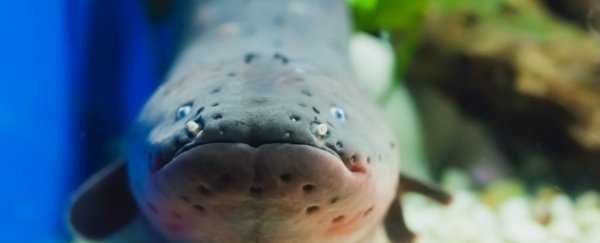Benjamin Franklin may or may not have flown a kite through lightning. But British scientist Michael Faraday, a 19th-century pioneer in electromagnetism, definitely grabbed an electric eel.
He wrote in awe of animals that gave the "same concussion to the living system as the electrical machine, the voltaic battery and the thunderstorm".
Faraday decided he had to hold one of these wriggling thunderclouds. When he gripped the fish near its head in one hand and its tail in the other, "the shock of this animal was very powerful," he wrote in 1838 in Philosophical Transactions.
The animals continue to electrify scientists. Kenneth Catania, a biologist at Vanderbilt University in Nashville, continued the tradition of getting zapped by eel.
He allowed a young electric eel to shock his forearm while he recorded the current. Catania reported the results of the experiment in the journal Current Biology on Thursday.
Catania is no stranger to an eels' jolts. "I've been accidentally shocked a couple of times. I knew roughly what I was in for," he said.
When asked how it felt to have an electric eel shock him on purpose, he said, "I was impressed. Let's put it that way."
The eels are stun gun, battery and remote control wrapped into one snakelike animal. (Technically speaking, they're not true eels but a species of Amazonian fish called knifefish.)
In the past few years, Catania has explored how the eels use weak pulses to sense prey. He showed that the eels' stronger pulses zap fish out of hiding, and that eels curl around their prey to deliver stunning high-voltage jolts.
Electric eels play a mean defense, too. In 2016, Catania confirmed a 200-year-old story, long thought a myth, that threatened eels leap out of the water to deliver a super-potent shock.
A recent viral video of a fisherman being knocked backward by a leaping eel piqued his interest further.
"I wanted to know more about the circuit that develops when the eel leaps out of the water," he said.
Catania began to construct the pieces of the living circuit. By holding an eel with specialised gloves, he determined its voltage - measuring, essentially, the strength of the battery within an eel.
He could also measure its resistance, or how readily it allows electricity to flow. (Batteries vary in resistance; a car battery's is very low, which is why touching the ends of jumper cables together gives off huge sparks.)
He could measure, too, the resistance of the water where the eels lived. But there was a missing piece of the eels' defensive circuit: The current, or rate of electrical flow, that the eels discharged from their bodies into their targets.
"I have told people many times that whenever possible you should collect data," Catania said. So the biologist took his own advice.
"This wasn't a crazy thing to be doing," Catania insisted, "especially when you scale it down to a juvenile eel."
(Faraday knew to use small eels too, studying the fish just over two-feet long - steer clear of the five-footers, he wrote.)
As the young eel slid its chin higher up Catania's arm, the fish-human combination acted like a variable resistor. If the eel was just a tiny bit out of the water, most of the current flowed back into the pool.
Higher up, the resistance increased, and more current was diverted through Catania's arm.
"It's a brilliant strategy," he said. "It's almost like the eel is turning up a volume knob."
As the animals gradually get closer to a target, then slip farther and farther out of the water, they'd deliver progressively more powerful jolts. "The circuitry explains how this would evolve," Catania said.
At full volume, the eel sent currents of 40 to 50 milliamperes coursing through Catania's arm. Ten milliamperes is painful.
Quintupling that triggered Catania's "involuntary withdrawal reflex," which is to say that his body jerked his hand away from the eel. In terms of wattage, the eel's pulses were nearly 10 times that of a stun gun.
Catania said he still has many questions to answer: How do the eels avoid shocking themselves? (There are hints of well-insulated nerve endings, he said, but the information isn't as clear as he'd like.)
Could they be sensing would-be predators, like crocodiles or jungle cats, before delivering a shock?
Before he began studying the fish, he thought of electric eels mostly as giant swimming batteries. They're far more interesting than that, he said. "There's so much that I'm not even sure what to do next."
2017 © The Washington Post
This article was originally published by The Washington Post.
